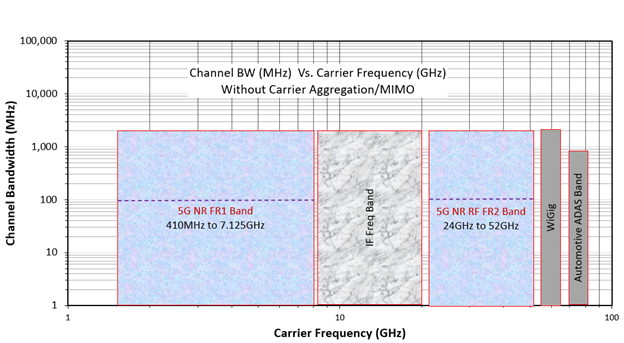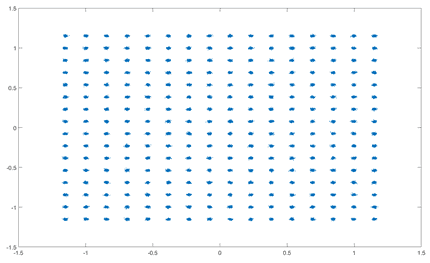Meeting the Challenges of 5G RF Production Test Services
5G射频(RF)标准的实现迅速增加[1]。在过去的四到六个季度中,侧重于出版物和产品被引入市场的产品。一些流行的RF生态系统应用程序包括手机,WiFi,汽车,物联网(物联网),位置服务等。WiFi和手机服务是数据密集型的,而在某些情况下,IoT可能需要有限的数据。
Based on the 4G mobile network’s unit volume metrics, the confidence levels on achieving the unit volumes in Figure 1 and total addressable market (TAM) with 5G standards definition appear to be high.

图1:5G产品预计强劲增长。Source: IoT Business News。
的re are plenty of similar plots showing such volumes from worldwide geographies developing products to 5G specifications. Higher 5G RF unit volumes are expected to result in higher unit volumes at test. Infrastructure developments and deployments are expected to precede the user equipment introductions. As shown in Figure 2, a typical cellphone application includes a base station with cellphone towers, each of which supports multiple users’ cellphones in the coverage area.

图2:Key ingredients of a two-way RF communication block diagram include an application processor (AP), baseband integrated circuit (IC), and radiofrequency integrated circuit (RFIC).
由于基站suppor的覆盖范围t multiple user equipment, the RF power requirement is higher relative to the user equipment. Base stations are powered by plug-in power, while the user equipment is designed to be power efficient because they are mobile and battery-powered. Since the magnitude of data downloaded on a typical cellphone is a couple of orders of magnitude higher than the data uploaded, the number of receive channels is typically larger than the number of transmit channels. Concepts like multiple-input, multiple-output (MIMO), and carrier aggregation (CA) [1] are employed at a protocol layer to increase the effective bandwidth. Receive channels employ diversity [1] to improve spatial performance. Even though these concepts are not the direct focus of this article, product architecture and design do have an impact on test requirements and test methodology. WiFi technology-based applications are typically within the home/office. Their maximum RF power is limited, yet the dynamic range is not, and their bandwidth is typically higher relative to cellphones.
的recent introduction of the 5G 3GPP standard [1], identifies carrier frequencies in two separate carrier frequency spectrums. As shown in Figure 3, FR1 carrier frequencies are in the 410 MHz to 7.125 GHz range and the FR2 carrier frequencies are in the 24 GHz to 52 GHz range. The allowable bandwidths exceed 100 MHz up to 2 GHz. The sub-carrier spacing is compacting and hence the need for tighter constraints for phase noise and gain flatness.

Figure 3:的5G carrier frequencies are defined in the 3GPP specifications [1].
5G NR(New Radio) 변조 방식
的re are two 5G NR signal modulation schemes – cyclic prefix orthogonal frequency division multiplexing (CP-OFDM) and discrete Fourier transform spread orthogonal frequency division multiplexing (DFT-S-OFDM) [1] (Figure 4).

Figure 4:在Adautest V93K上捕获了256正交幅度调制(256-QAM)5G NR星座曲线图。
CP-OFDM用于下行链路(D / L),具有正交相移键控(QPSK),16-QAM,64-QAM和256-QAM。它具有高光谱效率,并与MIMO和4G LTE定义兼容。DFT-S-OFDM用于上行链路(U / L),具有π/ 2-二进制相移键控(BPSK),16-QAM,64-QAM和256-QAM。它具有更复杂的实现,并且与CP-OFDM相比具有更少灵活的资源分配,并且它不与MIMO结合使用。5G NR的五个子载波间距在15kHz至240kHz之间。图4显示了256 QAM图。
5G RF 제품 & RFIO
Modern direct and heterodyne converter architectures [2] have digital baseband I/O. The digital baseband feeds the data to a digital-to-analog converter (DAC) that creates the analog in-phase and quadrature (I/Q) waveforms. These waveforms, when mixed with a local oscillator (LO) signal, up-convert the data to produce the modulated intermediate frequency (IF) or RF signal that is transmitted to the receiver (Rx). The signal transmission occurs over a coaxial shielded cable or over the air. Prior to transmission, especially when it is over the air, the signal may require signal amplification. Also, the receiver may require the received signal to be amplified prior to supplying the signal for down-conversion. The down-converted signal is fed to an analog-to-digital converter (ADC) that converts the signal to digital baseband for processing by the application processor. Figure 5 shows these steps.

图5:Simplified transmitter (Tx) and Rx RF chain blocks.
Integrated device manufacturer (IDM) customers bring a variety of RF products for assembly and test services. This includes, and is not limited to transceivers, low-noise amplifiers (LNA), power amplifiers (PA), digital step attenuators (DSA), filters, and mixers. Depending on the target application, the number of RF input and output channels may be different. Bandwidth, phase noise, intermodulation distortion (IMD), phase and amplitude resolution/accuracy, and other test requirements may vary as well.
的device under test’s (DUT’s) transmitter characteristic specifications for production testing includes transmitting power and RF spectrum emissions (occupied bandwidth, out of band emissions, adjacent channel leakage ratio (ACLR), and IMD). DUTs Receiver characteristic specifications for production testing include receiving sensitivity, maximum input levels, adjacent channel selectivity, blocking, spurious response, and IMD [1].
5g rf하위시스템을이용한한자동화된테스트(吃)테스터테스터툴링(工具)
最近,Teradyne,National Instruments和Cohu最近公开发布了他们成熟的吃的升级路径。AMKOR利用ATE的RF子系统硬件和软件仪器基础架构来测试生产工厂的客户产品。
ATE供应商通常架构架构仪器资源的通用超集配置,以便客户测试应用程序开发。任意波形发生器(AWG),数字化器(DGTS),LOS,滤波器,放大器,音调组合器,传输信号分路器,接收信号交换机,以及它们宽带宽和动态操作范围的折衷和动态的操作范围当前必须考虑的权衡每位客户的新5G RF应用程序。从仪器设计的特定应用频率和振幅处的相位噪声对误差矢量幅度(EVM)测试有直接影响。在100kHz和-10dB或更好的偏移中的相位噪声或更好的是在5G的连续波(CW)频率下是可接受的(典型的)。在典型的宽带客户产品应用中,需要切换频率和幅度。切换时间影响整个测试列表执行时间。具有最小切换时间的测试人员是生产测试中最有效的。图6示出了ATE框图。

Figure 6:简化的ATE框图。
Custom tooling (probe cards and/or load boards) must be developed to help route tester resources to devices, pins, or bumps. For wafer probe services, probe card vendors deliver probe pin technologies. For 5G RF carrier frequencies that are above 50 GHz, the challenges include impedance matching and pin to pin and site to site signal isolation. For packaged parts, load board, socket, and socket-pin technology vendors deliver pin technologies. For 5G RF carrier frequencies, challenges are similar to the ones described for probe pins. Acceptable levels of insertion loss (S-parameter S21) at these frequencies are typically no more than -10 dB and return losses (S11) over the frequency range are typically better than -10 dB. Acceptable levels of pin-to-pin isolation for typical applications are better than -45 dB over the range of frequencies.
供应商保证RF性能和精度规范,以测试头信号传送界面。测试仪供应商开发和提供校准系统(硬件和软件)以在记录的规格中进行校准,验证和诊断性能。RF Instruments的精度规格对温度波动敏感。在大多数情况下,温度±5°C(或更紧密)的温度变化触发了仪器的自校准程序。电源,信号(数字,模拟/ rf)和时钟需要将校准平面从测试头移动到设备引脚。该路径包括探针卡或装载板上的迹线。我们具有采用去嵌入技术和使用环回或定制短路,打开,负载,通过(SOLT)结构的独特优势,以帮助将所需的RF信号精度提供给所测试的设备。在大多数情况下开发定制标准进行校准需要额外的努力,但是,随着内部包装设计,大道确实存在。在大多数情况下,Golden Loopback DUT技术足以实现所需的准确性。
装配测试附件
我们的装配和测试部门密切合作,使5G RF工程开发能够进行生产测试。好处是从同一工厂位置提供的完整组装和测试交钥匙解决方案。5G封装在包装和天线上提供天线(AIP / AOP)SIP是2018年7月的首次由Amkor制作,并在2019年的公共新闻稿中宣布[3]。
随着装配和包装技术的最新进步,RFIC,如5G收发器和RF前端(RFFE)设备,可以在包装中嵌入天线。类似地,包装(SIP)设备中的系统具有相同的相关组件,如处理器,存储器,RFIC外设,包括功率放大器,低噪声放大器,相位阵列和IC包内的天线结构的离散组件[4]。天线形成前端的关键组件,并且需要调谐特定频带的操作。如今所定义的,今天正在设计的5G NR FR2兼容客户产品正在进行于特定操作频段的性能调整[1]。数据密集型应用可能需要在包装中打包多个无线电,因此需要每个频带调谐的多个天线。
所有生产测试的所有RF器件的生产测试都是导电的。来自DUT的RF I / O与电缆上的阻抗控制路径电连接,并屏蔽印刷电路板(PCB)微迹线到测试仪的RF仪表。如上所述,所有ATE供应商开发5G RF测试溶液包括导电RF同轴互连。为了使具有嵌入式天线的封装的高批量生产测试,测试方法需要具有最小和受控信号损耗的互连,其可以发送或接收RF能量。天线传输理论[7],需要最小的发射器和接收器之间的空间分离。这种分离取决于载波频率。RF I / O通道的数量和多站点测试要求增加了生产测试复杂性。目前正在探索的测试选项包括补丁和喇叭天线,波束成形IC(BFICS),嵌入式定向耦合器和波导。这些解决方案都不是高批量制造友好,也不是随着天线的数量增加而可扩展的。这主要是由于测试器接口处理程序中的物理空间要求。
IDMs have been architecting design structures that allow loopback Design for Excellence (DfX) modes on transceivers to help simplify and make production test equipment requirements economical. While an antenna embedded within the package offers added miniaturization and overall integration, it does take away the flexibility of final performance tuning of the application for the new 5G NR operating band of carrier frequencies. The company continues to partner with suppliers and customers to solve the over-the-air (OTA) test challenges for production testing.
부가가치 제안
상위레벨에는두가지주요생산테스트운영이있습니다。첫번째테스트운영모델은이테스트컨텐츠와5g rf테스트장비를선정하여앰코가생산에사용하도록하도록하는것것것두번째테스트운영모델은테스트가능하게하게하는요청엔지니어링엔지니어링서비스를제공제공고객이경우,테스트테스트개발팀팀은고객긴밀히협력하고각고객의테스트개발(TDE)요구사항에에맞춤형사항항을충족충족충족충족충족충족부가적인tde서비스의예는다음을포함이에국한되지않습니다:
- 일치하는5g지원테스터선택
- 일치하는 프로버 및 핸들러 선택
- 적절한 테스터 리소스 할당, 특히 다중 사이트 생산 테스트를 위한 일치하는 5G테스트 툴(프로브 카드, 로드 보드) 설계
- 根据客户的功能测试规范开发和调试生产测试程序,测试模式和测试波形,
- 제품 검증,
- 제품특성테스트루틴
- Yield optimization, low yield failure analysis, and product design feedback. (Failure analysis may, for example, require X-ray or de-lamination to determine the root causes of fabrication and assembly packaging defects.),
- 맞춤형 백 엔드 플로우로 완제품을 효율적으로 처리할 수 있습니다.
的RF test development engineering group has significant experience developing test solutions and test content for previous and present generations of RF technologies and continues to build upon this expertise to solve 5G test challenges described here. The group is actively engaged in creating and proposing test solutions for base station and mobile 5G RF products in both FR1 and FR2 RF spectrum. These test solutions make use of the 3GPP standard-compliant ATE hardware and software test tools described above.
多年来内部生产测试过程已经成熟,并允许实施制造(DFM)规则设计为5G RF生产测试。收集,分析和保留5G RF生产试验的制造测试结果对于对测试方法,流动和内容的增量改进至关重要。在特定情况下,测试工程师为IC设计和制造工艺工程提供有价值的反馈。建立了5G RF测试结果的统计箱限制(SBL)在测试设备船队中为多射频测试结果可以帮助识别系统的设备相关的虚假故障,并帮助消除这些因素。这确保了最佳的测试设备利用率并提高了整体生产吞吐量。
A good portion of customers have products with critical time-to-market (TTM) goals and are sensitive to intellectual property (IP) contamination and security. Mature systems and processes are in place to handle all such customer concerns.
Amkor production test has been preparing to test the large number of 5G products that are expected in the coming years. This includes the 5G base station and infrastructure equipment that is expected to precede user equipment (mobile devices) growth.
요약
的5G RF production test business is substantial in size and growing rapidly. Our production test teams have been working closely with assembly packaging, ATE suppliers, and customers to ensure that holistic 5G RFproduction test servicesare made available to meet and exceed all test capability and capacity challenges.
참고 자료
- 3GPP.TS 38.101-1 V16.1.0(2019-09)。
- Wide Band RF Architecture options – Peter Delos,Analog Devices。
- Amkor Device Packages
- Antenna In Package/Antenna On Package
- Amkor Antenna in Package –文章。
- Amkor Packages – Press Release 2019
- 菲涅耳远远地区orAntenna Theory
작성자 정보
Vineet Pancholi,SR Director Test技术,Amkor Technolbob体彩ogy,Inc。在坦佩,AZ。Vineet于2019年1月加入了Amkor,目前为5G RF和高速数字生产测试方法提供了测试技术开发。在加入Amkor之前,Vineet在Microchip技术进行了测试开发中。此前,他在英特尔在英特尔度过了19年的一系列测试角色,包括测试仪供应商管理,测试技术开发(烧坏,最终和系统级测试)和RF测试仪建筑师。Vineet持有半导体器件测试人员专利,并在亚利桑bob软件那州立大学赢得了硕士学位的物理和电气工程学位。



